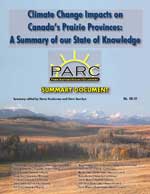The Prairie Provinces
PARC's Latest Research on Impacts and Adaptation on the Prairie Provinces
The climate of Saskatchewan and the Prairie Provinces is changing. In fact, next to northern and arctic Canada, the climate of the Prairie Provinces is the fastest changing climate in Canada. While much remains to be studied, there is already abundant research completed on the trends and impacts of climate change in the Prairie Provinces. Two recent reports, coordinated by PARC, have been completed:
Climate Change and the Prairies
In 2007, 14 Prairie scientists, organized by PARC, completed an extensive survey and summary of what we know so far about climate change in Prairies Canada.
Climate Change Impacts on the Prairie Provinces: Key Conclusions
- Water: There will be lower summer streamflows, falling lake levels, retreating Rocky Mountain glaciers and declining soil moisture. Less water will be stored as winter snow and ice - which was historically a reliable and important source of water. Water scarcity may constrain economic and population growth in Alberta.
- Extreme Events: Within the framework of an environment that is tracking warmer and drier, there will be more flood events, severe storms and climatic extremes. The climate is becoming increasingly variable season to season and year to year.
- Drought: Droughts of extreme severity or long duration are an increasing threat to communities and industries, particularly agriculture.
- Summer: Generally summers will be especially dry.
- Temperature: Much of the projected temperature increase will occur in winter and spring. There will be reduced energy demand for heating and higher demand for cooling.
- Winter: A shorter, warmer, winter season will make winter ice roads less viable and will hinder some forestry and energy industry operations. Some agricultural and forest pests will survive warmer winters more easily - mountain pine beetle is a serious threat. Ice-fishing, snowmobiling and skiing may decline.
- Soil Moisture: Higher potential forest, grassland and crop productivity from increased heat and atmospheric CO2 will be limited by available soil moisture.
- Ecosystem Change: There will be major ecosystem changes. Aquatic habitats will be stressed and some fish and waterfowl populations will decline. Non-native plants and animals will appear on the landscape, while some native species will decline or disappear entirely. The southern boreal forest is at serious risk.
- Disease: Some vector-borne diseases, such as West Nile virus and hantavirus pulmonary syndrome, could become more common.
- Vulnerability: The most vulnerable people to climate change impacts include the elderly, children, the poor, those with underlying health problems, farmers and Aboriginal peoples.
- Adaptation: Adaptation to climate change is necessary. Examples include: minimum tillage practices and crop diversification in the agricultural sector, infrastructure and water conservation programs across the Prairies, new water policy in Alberta, and re-engineering of the Red River floodway in Manitoba. On-going research at the Saskatchewan Watershed Authority and PARC will improve our understanding of Saskatchewan stream and river flows. All of these measures enhance resilience and increase adaptive capacity.
- GHG Reductions: Climate change impacts are on-going and the acceleration of impacts is now inevitable. To avoid the most damaging worst-case climate change impacts scenarios, significant reductions in greenhouse gas emissions are urgently required.
Next Page › The World
Sources:
- Henderson, N. and Sauchyn, D. editors (2008): Climate Change Impacts on Canada's Prairie Provinces: A Summary of our State of Knowledge. PARC Summary Document No. 08-01, 19 p.
- Sauchyn, D. and Kulshreshta, S. (2008): Prairies; in From Impacts to Adaptation: Canada in a Changing Climate 2007, edited by D.S. Lemmen, F.J., Warren, J. Lacroix and E. Bush; Government of Canada, Ottawa, ON p. 275-328.

